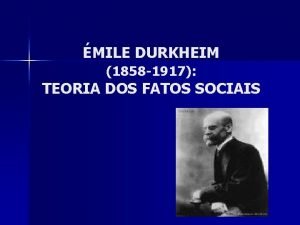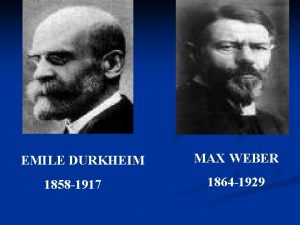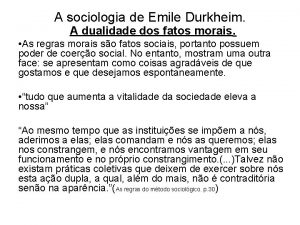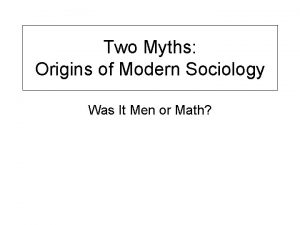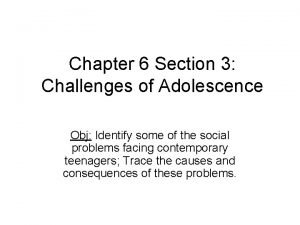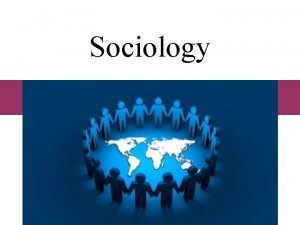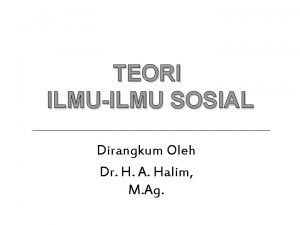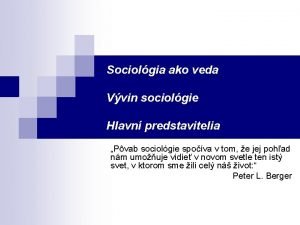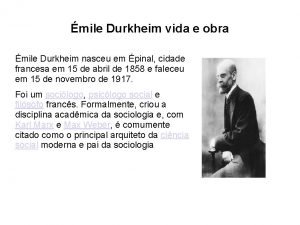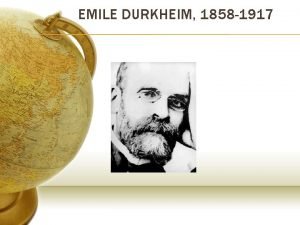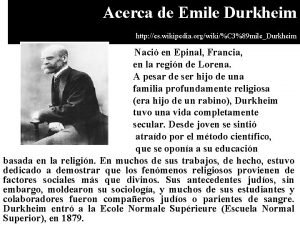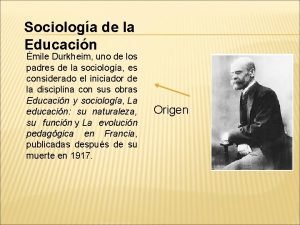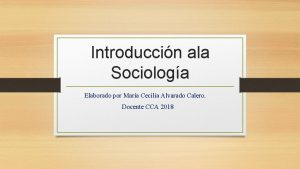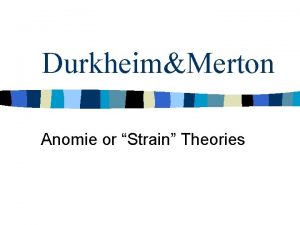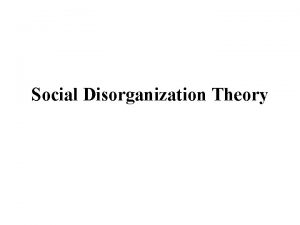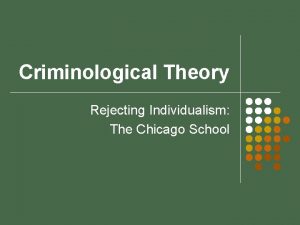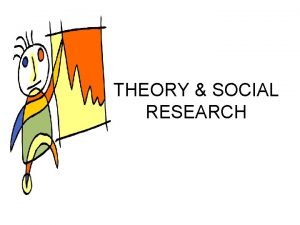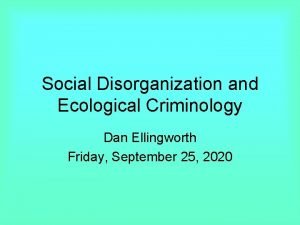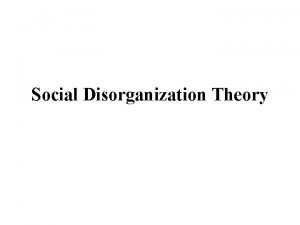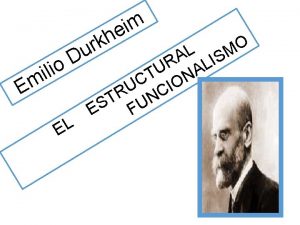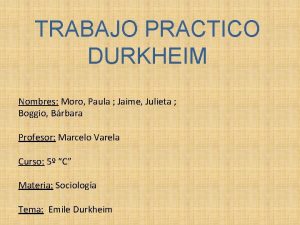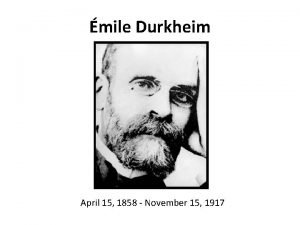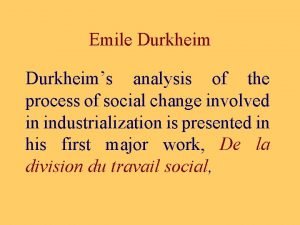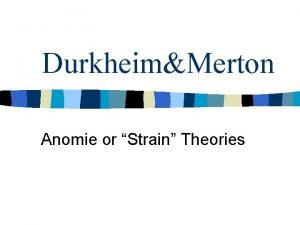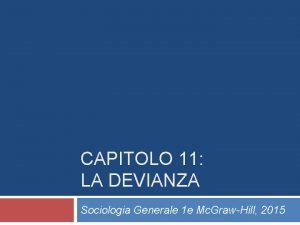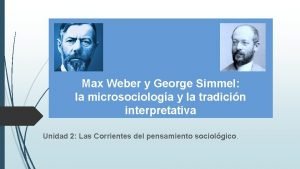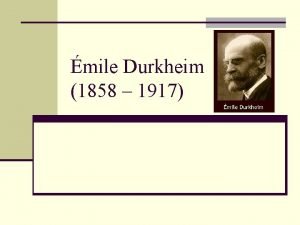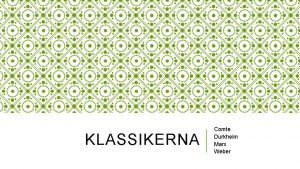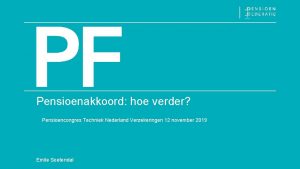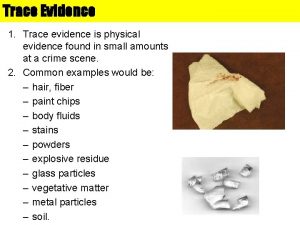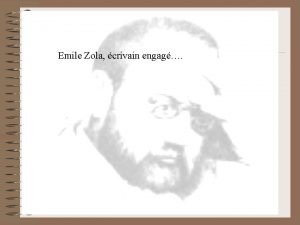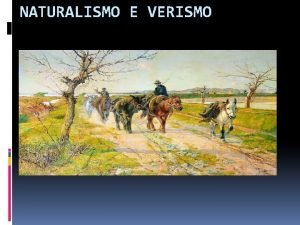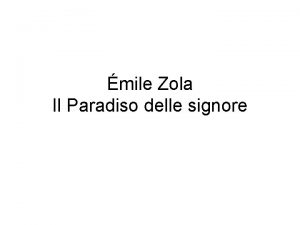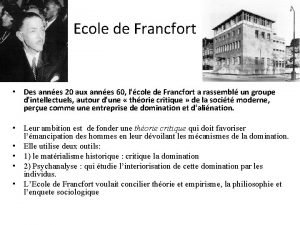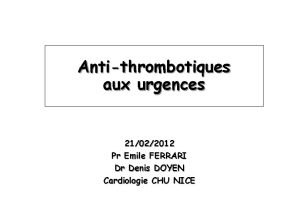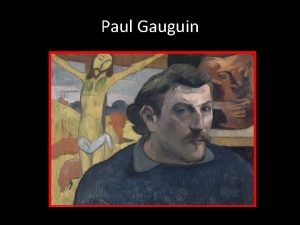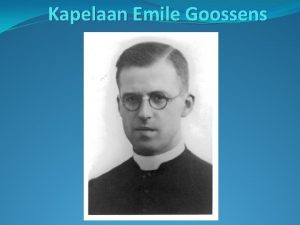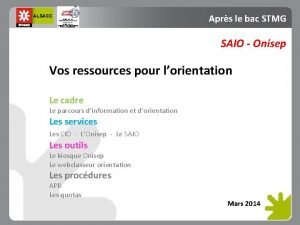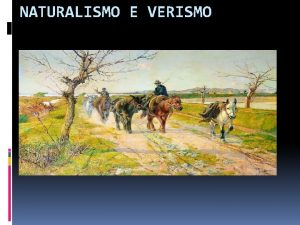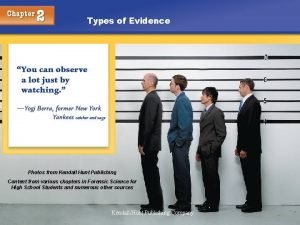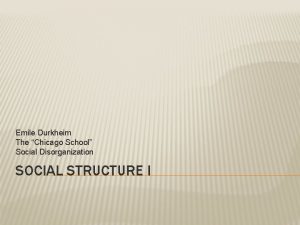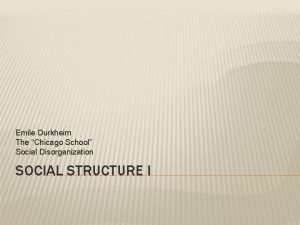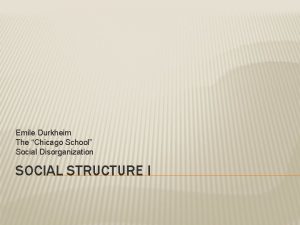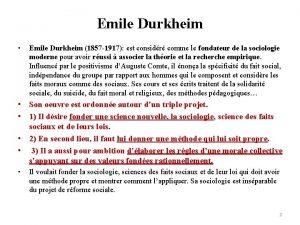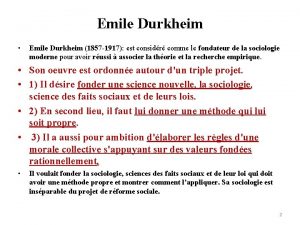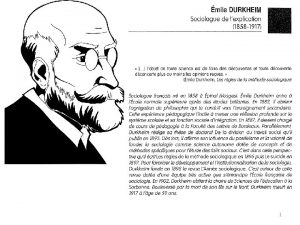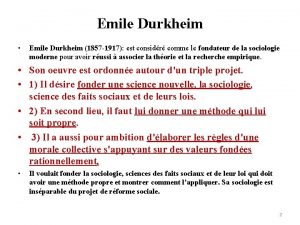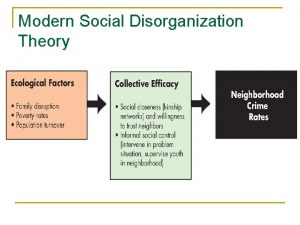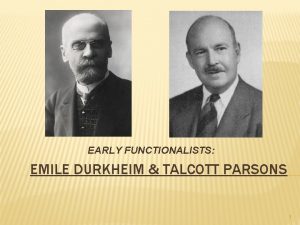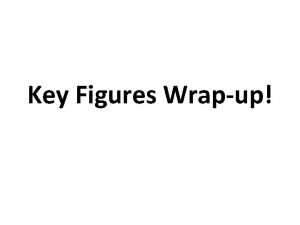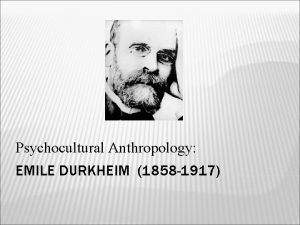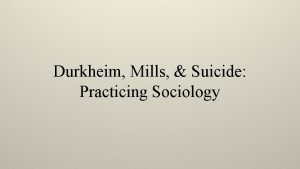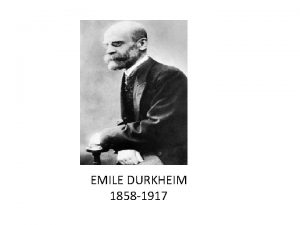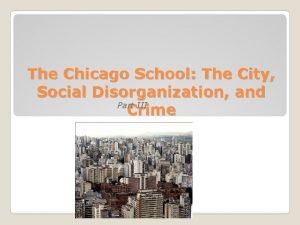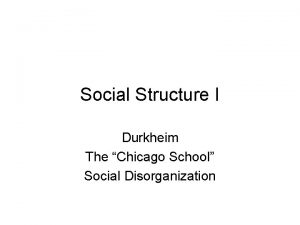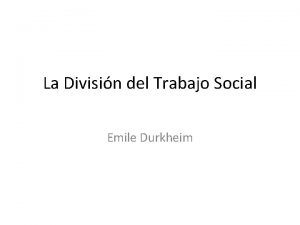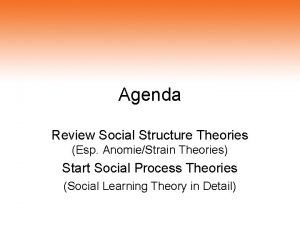Emile Durkheim The Chicago School Social Disorganization AnomieStrain






























































- Slides: 62

Emile Durkheim The “Chicago School” + Social Disorganization Anomie/Strain Theories SOCIAL STRUCTURAL THEORIES

EMILE DURKHEIM (LATE 1858 -1917) French Scientist Suicide Humans nature: selfish and insatiable Effective Societies able to “cap” desires Socialization Special Coined & Social Ties concern with “Industrial Prosperity” the Term “Anomie”: Institutionalized norms lose ability to control human behavior and human needs

DURKHIEM’S LEGACY Rapidly Changing Society “Industrial Prosperity” Anomie (Norms are Weakened) The Anomie/Strain Tradition Human Nature as Insatiable; must therefore cap or control Social Ties Important The Social Disorganization and “Informal Control” Tradition

PARK & BURGESS (1925) How does a city growth and develop? Concentric Zones in Chicago Industrial zone Zone in transition Residential zones

SHAW AND MCKAY Juvenile Delinquency in Urban Areas 1942. Mapped addresses of delinquents (court records) Zone in transition stable and high delinquency rates over many years Implications of these findings: 1. Stable, despite multiple waves of immigrants!! 2. Only certain areas of the city Something about this area causes delinquency

SOCIAL DISORGANIZATION What were the characteristics of the zone in transition that may cause high delinquency rates? Population Heterogeneity Population Turnover Physical Decay Poverty/Inequality Argue that these things impede informal social control One started, crime becomes stable because delinquent values are transmitted?

SAMPSON AND GROVES (1989) Using British Crime Survey Data (BCS) ECOLOGICAL CHARACTERISTICS • Population turnover • Poverty / inequality • Divorce rates • Single parents SOCIAL CONTROL • Street supervision • Friendship networks • Participation in organizations CRIME (VICTIMIZATION)

SAMPSON FRIENDS (1997 -PRESENT) VERSION Data from the Project on Human Development in Chicago Neighborhoods Concentrated Disadvantage (Ecological) • Population turnover • Poverty / inequality • Race composition • Family disruption • Physical decay Collective Efficacy • Willingness to supervise/confront in neighborhood • Mutual trust and willingness to help neighbors CRIME • Homicide • Violence as “problem” • Victimization

RETURN OF THE “CULTURAL TRANSMISSION” William J. Wilson (Concentrated Poverty) The “Underclass” or “Truly Disadvantaged” Cultural Isolation no contact with “mainstream” individuals/institutions Little respect for “life” Hyper materialism, violence as “normative” Some believe recent “crime drop” reflect move away from these values

S. D. AS AN EXPLANATION FOR HIGH RATES OF AFRICAN AMERICAN OFFENDING William Julius Wilson and Robert Sampson High proportion of the current members of the “Zone in Transition. ” Public Policy made matters worse (high rise “projects” of the 1950 s-60 s) Why do African Americans not “move out” like prior ZIT residents (immigrants)? Housing Segregation Loss of Manufacturing Jobs The irony of “Black Flight”

POLICY IMPLICATIONS? Build neighborhood “collective efficacy” How do you do this? Address ecological characteristics that ruin collective efficacy Family disruption, concentrated poverty, residential mobility

ROBERT K. MERTON Social Structure and Anomie (1938) From Durkheim: Institutionalized norms are weakened in societies that place an intense value on economic success Applied this to the United States The “American Dream”

STRAIN THEORY (MICRO LEVEL) MODES OF ADAPTATION CULTURAL INSTITUTIONALIZED GOALS MEANS 1. Conformity + + 2. Innovation + - 3. Ritualism - + 4. Retreatism - - 5. Rebellion +/-

CRITICISMS OF MERTON’S STRAIN THEORY Is crime a “lower class” phenomena? Cannot explain “expressive” crimes Weak empirical support Why do people “adapt” differently?

AGNEW: GENERAL STRAIN THEORY Overhaul of Merton’s Strain Theory Three sources of strain 1. 2. 3. Failure to achieve valued goals Removal of valued stimuli Can’t escape noxious stimuli

AGNEW (GST) Strain Negative Anger, In Affective States fear, frustration, depression lieu of “Coping Mechanisms, ” anger and frustration can produce delinquency Strain Neg Emotional Delinquency

CRIME AND THE AMERICAN DREAM Messner and Rosenfeld

ELEMENTS OF THE “AMERICAN DREAM” Achievement Individualism Universalism The “fetishism” of money These elements encourage “Anomic conditions”

INSTITUTIONS IN SOCIETY Social institutions as the building blocks of society. The Economy The Polity The Family Education

CULTURE, SOCIAL STRUCTURE, AND CRIME RATES CULTURE SOCIAL STRUCTURE The American Dream Economic Dominance ANOMIE Weak Institutional Controls HIGH CRIME RATES

INFORMAL SOCIAL CONTROL THEORIES Hirschi (social bond) Gottfredson and Hirschi (low self-control) Sampson and Laub (age graded social control)

ASSUMPTIONS ABOUT “MOTIVATION TOWARDS CRIME” Strain theory: motivation from some sort of strain (e. g. blocked opportunity) Learning theory: motivation from delinquent peers Control theory: there is enough natural motivation towards crime No need to “build in” extra motivation Real question? Why aren’t we all criminal?

TYPES OF CONTROL Direct Control Direct punishments, rewards from parents, friends Indirect Control Refrain from deviance because you don’t want to risk friends, job, etc. Internal Good Control self-concept, self-control, conscience

SOCIAL BOND THEORY “Bond” indicates “Indirect Control” Direct controls (punishment, reinforcement) less important because delinquency occurs when out of parents’ reach (adolescence). Attachment Commitment Involvement Belief (Elements of the social bond are all related to each other)

GOTTFREDSON AND HIRSCHI (1990) A General Theory of Crime Same control theory assumptions If we are all inclined to be deviant, why conform? Because most of us develop “self-control” “Internal control” Developed by age 8, as the result of “direct control” from parents

NATURE OF CRIME, NATURE OF LOW SELFCONTROL Criminal Acts… People with low self-control are therefore… Provide immediate gratification of desires Impulsive Are risky/thrilling Are easy/simple Require little skill/planning Risk-taking Physical (as opposed to mental) Low verbal ability Provide few/meager long term benefits Short-sighted Result in pain/discomfort to a victim Insensitive

GOTTFREDSON AND HIRSCHI Family Context Low Direct Control Low Self. Control • Large family size, single parents, parental deviance • Inadequate supervision, recognition, punishment • Insensitive, impulsive, risk-taking…

“AGE GRADED THEORY OF INFORMAL SOCIAL CONTROL” Sampson and Laub We will cover this again in the “lifecourse” theory section Takes Hirschi’s (1969) theory and made it “age graded” The specific elements of the social bond change over the life-course Also includes elements of “direct control” Also throws in some other stuff (integrated theory)

SAMPSON AND LAUB Childhood Context Individual Differences Adolescence Parenting • Supervision • Discipline Social Bonds • Family • School Delinquent Peers Adulthood Delinquency Length of Incarceration Adult Crime Social Bonds • Marriage • Good Job

POLICY IMPLICATIONS Hirschi’s Target Social Bond Theory attachment, commitment, belief Gottfredson and Hirschi’s General Theory Must focus on early childhood prevention Train parents? Sampson Different and Laub targets for different ages Importance of adult bonds (job, marriage)

SOCIAL PROCESS THEORY TRADITIONS ▪ Differential association/social learning ▪ ▪ Adequate socialization toward the incorrect norms and values Informal social control ▪ ▪ Inadequate socialization Labeling theory ▪ Socialized to accept delinquent identity as result of criminal justice system

DIFFERENTIAL ASSOCIATION Criminal Behavior is learned Negatively, this means it is not “invented” Communication within intimate groups Learning Attitudes involves techniques and attitudes expresses as “definitions of the situation” A person becomes delinquent because of an “excess of definitions favorable to law violation” The process involves the same learning process as all other behavior

TECHNIQUES OF NEUTRALIZATION ▪ ▪ Developed by Sykes and Matza First good attempt to measure Sutherland’s “definitions” Documented common rationalizations (excuses) for delinquency among a sample of delinquents

TECHNIQUES OF NEUTRALIZATION ▪ ▪ ▪ Denial of responsibility Denial of injury Denial of victim Condemnation of the condemners Appeal to higher loyalties

TECHNIQUES OF NEUTRALIZATION Definitions or Something Else? ? ▪ Sociology criticism Such attitudes do not actually cause criminal behavior. ▪ ▪ Rationalization is utilized only after the offense is committed when behavior is called into question. Psychologist (Behaviorism): To the extent that these rationalizations neutralize guilt, they reinforce behavior (Negative Reinforcement)

SOCIAL LEARNING THEORY ▪ ▪ Developed by Ronald Akers Early version: differential reinforcement ▪ ▪ Revision of differential association theory Added concepts of operant conditioning and imitation (observational learning) to explain how behavior was learne

SOCIAL LEARNING THEORY Key concepts ▪ Differential associations ▪ Definitions ▪ Differential reinforcement ▪ Imitation

SOCIAL LEARNING THEORY (AKERS) Exposure to definitions or different role models DA Balance of definitions or role models produces initial behaviors Definitions Role models Behaviors Positive or negative reinforcement R(+/-)

SOCIAL LEARNING THEORY ▪ Empirical research measures ▪ ▪ ▪ Attitudes that support crime (definitions) Exposure to delinquent peers/family members (differential associations) Rewards or punishment for delinquency (differential reinforcement)

POLICY IMPLICATIONS: SOCIAL LEARNING THEORY ▪ Use the principles of learning to ▪ ▪ Reduce access to delinquent peers Confront and change antisocial attitudes Change the balance of reinforcement so that it supports prosocial behavior Behavioral/cognitive restructuring programs

LABELING THEORY ▪ Developed by Frank Tannenbaum, Edwin Lemert, and Howard Becker Key concepts ▪ ▪ Emphasis is on interactions between individuals and institutions of formal control (e. g. , police, courts, prisons). Contact with police and the courts may create negative self-image. Formal interventions may increase criminal behavior.

ROOTS OF THE LABELING PERSPECTIVE (1 OF 3) ▪ View of crime and deviance as relative ▪ ▪ Deviant categorization depends on many factors Focus on how power and conflict shape society (social context) Moral entrepreneurs ▪ ▪ Importance of self-concept ▪Symbolic interactionism and “Looking-glass self”


A CRITIQUE OF LABELING THEORY ▪ ▪ Little empirical support Inaccurate assumptions ▪ ▪ ▪ Primary deviance as relative, sporadic, and unimportant Nature of the person predicts official reaction more than the nature of the act Effect of official sanctions on future behavior Racial bias does exist…but not sole (or most important) cause of CJ response to crime Arrest sometimes decreases future crime

POLICY IMPLICATIONS: LABELING THEORY ▪ Policy implications ▪ ▪ Schur: “Radical nonintervention” Juvenile Justice and Delinquency Prevention Act (1974) ▪ Diversion programs ▪ § § Divert offenders away from the formal juvenile justice processing to programs run by other entities (i. e. , social service programs) Deinstitutionalization (esp. status offenders) Due Process revolution in Juvenile Court

LABELING THEORY IN CONTEXT Labeling theory most popular in 1960 s-1970 s The central ideas had been around as early as the 1930 s Good “fit” for the social context of 1960 s Ironic Twist Government, trying to do good, actually makes people worse Good fit with the “can’t trust the government” social movement era

LABELING EXTENSIONS II ▪ Reintegrative Shaming – ▪ Developed by John Braithewaite Effect of formal punishment depends upon how a person is punished. ▪ ▪ Shaming and reintegrative punishment will decrease future crime. Stigmatizing punishment will increase future crime. LEADS TO RESTORATIVE JUSTICE

CRITICAL THEORY Central Themes Emphasis on “inequality” and “power” Crime as “political” concept CJS serves interests of powerful Solution to crime is more equitable society EXPLANATION OF LAW and CJ SYSTEM rather than crime

VARIATIONS OF CRITICAL THEORY Conflict Theory Marxist/Radical Theory Feminist Criminology/Gender and Crime

PLURALISTIC CONFLICT— EXPLANATION OF THE LAW AND CRIMINAL JUSTICE �George Vold Group Conflict � Multiple groups in society with varying levels of power ▪ Political interest groups ▪ Social movements ▪ Broad segments of society ▪ Political parties � Those who win conflict get control over the law and coercive power of the state

EMPIRICAL EVIDENCE The formulation of law Interest groups’ influence on law-making Research on consensus over laws The operation of the CJS Research “Legal” on “extra-legal” variables = prior record, offense seriousness “extra” = RACE, CLASS, GENDER Demeanor?

WHERE THE EVIDENCE IS CLEAR Race and Capital Punishment Victim Race x Race interactions and Drug Prosecutions Long history of connecting drugs to “dangerous” populations Chinese Opium Mexicans Marijuana African Americans Crack Cocaine e “Crack Multiplier” Enforcement patterns for drug offenses

MARXIST/RADICAL CRIMINOLOGY Instrumental Hard Marxist Position line position Crime and the creation and enforcement of law the direct result of capitalism Structural Softer Marxist Position Governments are somewhat autonomous Over time, the direction of the law (creation and enforcement) will lean towards the capitalists

IMPLICATIONS FOR LAW Capitalists Laws control the definition of crime protect the capitalists (property, $) Laws ignore crimes of the capitalists (profiteering)

IMPLICATIONS FOR THE CRIMINAL JUSTICE SYSTEM CJS is the tool of the capitalists; used to oppress (not protect) the working population Crimes of the rich treated with kid gloves Property crimes strictly enforced “Street crimes” are enforced only in poor neighborhoods Incarceration to control surplus labor

CRITICISMS RADICAL/MARXIST CRIMINOLOGY An “underdog theory” with little basis in fact Are “socialist societies” any different? Other capitalist countries have low crime rates Most crime is poor against poor—Marxists ignore the plight of the poor.

JEFFREY REIMAN ▪The Rich Get Richer and the Poor Get Prison ▪ ▪ Key point = harmful acts of the rich are often ignored (unneccesary surgery, environmental harm, etc. ) White collar crime less serious and less likely to be enforced ▪ Pollution, Hazardous work conditions, Unsafe products, Insider trading, Embezzlement, Fraud Even wealthy people who engage in street crime are less likely to be formally charged and better able to avoid sanctioning

GENDER AND CRIME Feminist Criminology Gender Ratio and Generalizability Relationships between gender, crime, and the criminal justice system

GENDER-CRIME ▪ Gender ratio (Gender Gap) ▪ Males account for the vast majority of delinquent and criminal offending ▪ ▪ UCR, NCVS, self-report Gender gap shrinking? � Liberation hypothesis (Not supported by research) WHY is gender ratio so large? § § § Can traditional theories explain? (Social bond, delinquent peers, etc. ) Masculinity & sex roles

GENDER AND CRIME II Generaliziblity Can issue “Male” theories explain female offending? Many theories blatantly sexist (See, Cohen) Many theories simply ignore females Mainstream theories do explain male and female offending similarly Could we do better explaining female criminality? Salience of sexual/physical abuse among delinquent girls

DALY’S TYPOLOGY OF FEMALE OFFENDING ▪ ▪ ▪ Street women Harmed-and-harming women Battered women Drug-connected women Other women

GENDER AND THE CRIMINAL JUSTICE SYSTEM ▪ Research findings ▪ When gender effects are found, females are treated more leniently Chivalry Hypothesis Paternalism Hypothesis Seriousness of offense differs in ways that most research doesn’t count Sort-of-legal-factors (“familied”)
 Emile durkheim 1858 a 1917
Emile durkheim 1858 a 1917 Emile durkheim fato social
Emile durkheim fato social Dualidade dos fatos morais
Dualidade dos fatos morais Social facts
Social facts What are the challenges of adolescence
What are the challenges of adolescence Examples of sociology
Examples of sociology Fakta sosial emile durkheim
Fakta sosial emile durkheim émile durkheim
émile durkheim Vida e obra de émile durkheim
Vida e obra de émile durkheim Kaderci intihara örnek
Kaderci intihara örnek Emile durkheim childhood
Emile durkheim childhood Klasifikasi kelompok sosial menurut emile durkheim
Klasifikasi kelompok sosial menurut emile durkheim Nociones vulgares
Nociones vulgares Emilio durkeim
Emilio durkeim Teorias sociologicas de emile durkheim
Teorias sociologicas de emile durkheim Emile durkheim
Emile durkheim Social disorganization theory definition
Social disorganization theory definition Chicago school criminology theory
Chicago school criminology theory Social disorganization
Social disorganization Social disorganization theory
Social disorganization theory Spatial disorganization
Spatial disorganization Que es un hecho social segun durkheim
Que es un hecho social segun durkheim Ejemplo de anomia
Ejemplo de anomia Teoria social de durkheim
Teoria social de durkheim Scuola di chicago e devianza
Scuola di chicago e devianza Menlo school library chicago style guide
Menlo school library chicago style guide Divisão do trabalho durkheim
Divisão do trabalho durkheim Fatti sociali per durkheim
Fatti sociali per durkheim Coersão social
Coersão social Durkheim
Durkheim Anomie definition sociology
Anomie definition sociology Durkheim anomie
Durkheim anomie Durkheim anomie
Durkheim anomie Devianza durkheim
Devianza durkheim Anomia durkheim
Anomia durkheim Pensamientos de max weber
Pensamientos de max weber Durkheim theory
Durkheim theory Durkheiniano
Durkheiniano Comte durkheim weber e marx
Comte durkheim weber e marx Durkheim solidarietà
Durkheim solidarietà Example of value consensus
Example of value consensus Techniek nederland verzekeringen
Techniek nederland verzekeringen Verga collegamento arte
Verga collegamento arte Emile gouws
Emile gouws Emile gourbin
Emile gourbin What is trace evidence examples
What is trace evidence examples Lettre a la jeunesse emile zola
Lettre a la jeunesse emile zola Maurice koechlin pronunciation
Maurice koechlin pronunciation Naturalismo e verismo
Naturalismo e verismo Il paradiso delle signore emile zola
Il paradiso delle signore emile zola Jacques emile blanche proust
Jacques emile blanche proust Emile le serpent mobile
Emile le serpent mobile Emile benveniste el aparato formal de la enunciacion
Emile benveniste el aparato formal de la enunciacion Karim emile bitar twitter
Karim emile bitar twitter College emile zola prahecq
College emile zola prahecq Emile ferrari
Emile ferrari Emile beldor
Emile beldor Dr emile bienvenue
Dr emile bienvenue L'onda di gauguin
L'onda di gauguin Emile goossens tm eu
Emile goossens tm eu Onisep tv stmg
Onisep tv stmg Emile zola corrente letteraria
Emile zola corrente letteraria Emile gourbin
Emile gourbin
